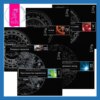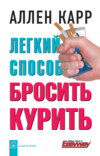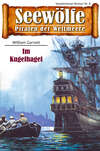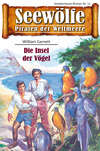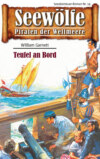Читать книгу: «Heroes of Science: Physicists», страница 14
In 1835 Faraday received a pension from the civil list; in 1836 he was appointed scientific adviser to the Elder Brethren of the Trinity House. In the same year he was made a member of the Senate of the University of London, and in that capacity he has exerted no small influence on the scientific education of the country, for he was one of those who drew up the schedules of the various examinations.
In his early years, Faraday thought that all kinds of matter might ultimately consist of three materials only, and that as gases and vapours appeared more nearly to resemble one another than the liquids or solids to which they corresponded, so each might be subject to a still higher change in the same direction, and the gas or vapour become radiant matter – either heat, light, or electricity. Later on, Faraday clearly recognized the dynamical nature of heat and light; but his work was always guided by his theoretical conceptions of the "correlation of the physical forces." For a long time he had tried to discover relations between electricity and light; at length, on September 13, 1845, after experimenting on a number of other substances, he placed a piece of silico-borate of lead, or heavy-glass, in the field of the magnet, and found that, when a beam of polarized light was transmitted through the glass in the direction of the lines of magnetic force, there was a rotation of the plane of polarization. Afterwards it appeared that all the transparent solids and liquids experimented on were capable of producing this rotation in a greater or less degree, and in the case of all non-magnetic substances the rotation was in the direction of the electric current, which, passing round the substance, would produce the magnetic field employed. Abandoning the magnet, and using only a coil of wire with the transparent substance within it, similar effects were obtained. Thus at length a relation was found between light and electricity.
On November 4, employing a piece of heavy-glass and a new horseshoe magnet, Faraday noticed that the magnet appeared to have a directive action upon the glass. Further examination showed that the glass was repelled by the magnetic poles. Three days afterwards he found that all sorts of substances, including most metals, were acted upon like the heavy-glass. Small portions of them were repelled, while elongated cylinders tended to set with their lengths perpendicular to the lines of magnetic force. Such actions could be imitated by suspending a feebly magnetic body in a medium more magnetic than itself. Faraday, therefore, sought for some medium which would be absolutely neutral to magnetic action. Filling a glass tube with compressed oxygen, and suspending it in an atmosphere of oxygen at ordinary pressure, the compressed gas behaved like iron or other magnetic substances. Faraday compared the intensity of its action with that of ferrous sulphate, and this led to an explanation of the diurnal variations of the compass-needle based on the sun's heat diminishing the magnetic permeability of the oxygen of the air. Repeating the experiment with nitrogen, he found that the compressed gas behaved in a perfectly neutral manner when surrounded by the gas at ordinary pressure. Hence he inferred that in nitrogen he had found the neutral medium required. Repeating his experiments in an atmosphere of nitrogen, it still appeared that most bodies were repelled by the magnetic poles, and set equatorially, or at right angles to the lines of force when elongated portions were tested. To this action Faraday gave the name of diamagnetism.
About a month after his marriage, Faraday joined the Sandemanian Church, to which his family had for several generations belonged, by confession of sin and profession of faith. Not unfrequently he used to speak at the meetings of his Church, but in 1840 he was elected an elder, and then he took his turn regularly in conducting the services. The notes of his addresses he generally made on small pieces of card. He had a curious habit of separating his religious belief from his scientific work, although the spirit of his religion perpetually pervaded his life. A lecture on mental education, given in 1854, at the Royal Institution, in the presence of the late Prince Consort, he commenced as follows: —
"Before entering on this subject, I must make one distinction, which, however it may appear to others, is to me of the utmost importance. High as man is placed above the creatures around him, there is a higher and far more exalted position within his view; and the ways are infinite in which he occupies his thoughts about the fears, or hopes, or expectations of a future life. I believe that the truth of that future cannot be brought to his knowledge by any exertion of his mental powers, however exalted they may be; that it is made known to him by other teaching than his own, and is received through simple belief of the testimony given. Let no one suppose for a moment that the self-education I am about to commend, in respect of the things of this life, extends to any considerations of the hope set before us, as if man by reasoning could find out God. It would be improper here to enter upon this subject further than to claim an absolute distinction between religious and ordinary belief. I shall be reproached with the weakness of refusing to apply those mental operations which I think good in respect of high things to the very highest. I am content to bear the reproach. Yet even in earthly matters I believe that 'the invisible things of Him from the creation of the world are clearly seen, being understood by the things that are made, even His eternal power and Godhead;' and I have never seen anything incompatible between those things of man which can be known by the spirit of man which is within him, and those higher things concerning his future which he cannot know by that spirit."
On more than one occasion the late Prince Consort had discussed physical questions with Faraday, and in 1858 the Queen offered him a house on Hampton Court Green. This was his home until August 25, 1867. He saw not only the magnetic spark, which he had first produced, employed in the lighthouses at the South Foreland and Dungeness, but he saw also his views respecting lines of electric induction examined and confirmed by the investigations of Thomson and Clerk Maxwell.
Of the ninety-five distinctions conferred upon him, we need only mention that of Commandant of the Legion of Honour, which he received in January, 1856.
JAMES CLERK MAXWELL
The story of the life of James Clerk Maxwell has been told so recently by the able pen of his lifelong friend, Professor Lewis Campbell, that it is unnecessary, in the few pages which now remain to us, to attempt to give a repetition of the tale which would not only fail to do justice to its subject, but must of necessity fall far short of the merits of the (confessedly imperfect) sketch which has recently been placed within the reach of all. Looking back on the life of Clerk Maxwell, he seems to have come amongst us as a light from another world – to have but partly revealed his message to minds too often incapable of grasping its full meaning, and all too soon to have returned to the source from whence he came. There was scarcely any branch of natural philosophy that he did not grapple with, and upon which his vivid imagination and far-seeing intelligence did not throw light. He was born a philosopher, and at every step Nature partly drew aside the veil and revealed that which was hidden from a gaze less prophetic. A very brief sketch of the principal incidents in his life may, however, not be out of place.
James Clerk Maxwell was born in Edinburgh, on June 13, 1831. His father, John Clerk Maxwell, was the second son of James Clerk, of Penicuik, and took the name of Maxwell on inheriting the estate at Middlesbie. His mother was the daughter of R. H. Cay, Esq., of North Charlton, Northumberland. James was the only child who survived infancy.
Some years before his birth his parents had built a house at Glenlair, which had been added to their Middlesbie estate, and resided there during the greater part of the year, though they retained their house in Edinburgh. Hence it was that James's boyish days were spent almost entirely in the country, until he entered the Edinburgh Academy in 1841. As a child, he was never content until he had completely investigated everything which attracted his attention, such as the hidden courses of bell-wires, water-streams, and the like. His constant question was "What's the go o' that?" and, if answered in terms too general for his satisfaction, he would continue, "But what's the particular go of it?" This desire for the thorough investigation of every phenomenon was a characteristic of his mind through life. From a child his knowledge of Scripture was extensive and accurate, and when eight years old he could repeat the whole of the hundred and nineteenth psalm. About this time his mother died, and thenceforward he and his father became constant companions. Together they would devise all sorts of ingenious mechanical contrivances. Young James was essentially a child of nature, and free from all conventionality. He loved every living thing, and took delight in petting young frogs, and putting them into his mouth to see them jump out. One of his attainments was to paddle on the duck-pond in a wash-tub, and to make the vessel go "without spinning" – a recreation which had to be relinquished on washing-days. He was never without the companionship of one or two terriers, to whom he taught many tricks, and with whom he seemed to have complete sympathy.
As a boy, Maxwell was not one to profit much by the ordinary teaching of the schools, and experience with a private tutor at home did not lead to very satisfactory results. At the age of ten, therefore, he was sent to the Edinburgh Academy, under the care of Archdeacon Williams, who was then rector. On his first appearance in this fashionable school, he was naturally a source of amusement to his companions; but he held his ground, and soon gained more respect than he had previously provoked ridicule. While at school in Edinburgh, he resided with his father's sister, Mrs. Wedderburn, and devoted a very considerable share of his time and attention to relieving the solitude of the old man at Glenlair, by letters written in quaint styles, sometimes backwards, sometimes in cypher, sometimes in different colours, so arranged that the characters written in a particular colour, when placed consecutively, formed another sentence. All the details of his school and home life, and the special peculiarities of the masters at the academy, were thus faithfully transmitted to his father, by whom the letters were religiously preserved. At thirteen he had evidently made progress in solid geometry, though he had not commenced Euclid, for he writes to his father, "I have made a tetrahedron, a dodecahedron, and two other hedrons whose names I don't know." In these letters to Glenlair he generally signed himself, "Your most obedient servant." Sometimes his fun found vent even upon the envelope; for example: —
Mr. John Clerk Maxwell,"Postyknowswere,"Kirkpatrick Durham,"Dumfries."
Sometimes he would seal his letters with electrotypes of natural objects (beetles, etc.), of his own making. In July, 1845, he writes: —
I have got the eleventh prize for scholarship, the first for English, the prize for English verses, and the mathematical medal.
When only fifteen a paper on oval curves was contributed by him to the Proceedings of the Royal Society of Edinburgh. In the spring of 1847 he accompanied his uncle on a visit to Mr. Nicol, the inventor of the Nicol prism, and on his return he made a polariscope with glass and a lucifer-match box, and sketched in water-colours the chromatic appearances presented by pieces of unannealed glass which he himself prepared. These sketches he sent to Mr. Nicol, who presented him in return with a pair of prisms of his own construction. The prisms are now in the Cavendish Laboratory at Cambridge. Maxwell found that, for unannealed glass, pieces of window-glass placed in bundles of eight or nine, one on the other, answered the purpose very well. He cut the figures, triangles, squares, etc., with a diamond, heated the pieces of glass on an iron plate to redness in the kitchen fire, and then dropped them into a plate of iron sparks (scales from the smithy) to cool.
In 1847 Maxwell entered the University of Edinburgh, and during his course of study there he contributed to the Royal Society of Edinburgh papers upon rolling curves and on the equilibrium of elastic solids. His attention was mostly devoted to mathematics, physics, chemistry, and mental and moral philosophy. In 1850 he went to Cambridge, entering Peterhouse, but at the end of a year he "migrated" to Trinity; here he was soon surrounded with a circle of friends who helped to render his Cambridge life a very happy one. His love of experiment sometimes extended to his own mode of life, and once he tried sleeping in the evening and working after midnight, but this was soon given up at the request of his father. One of his friends writes, "From 2 to 2.30 a.m. he took exercise by running along the upper corridor, down the stairs, along the lower corridor, then up the stairs, and so on until the inhabitants of the rooms along his track got up and laid perdus behind their sporting-doors, to have shots at him with boots, hair-brushes, etc., as he passed." His love of fun, his sharp wit, his extensive knowledge, and above all, his complete unselfishness, rendered him a universal favourite in spite of the temporary inconveniences which his experiments may have occasionally caused to his fellow-students.
An undergraduate friend writes, "Every one who knew him at Trinity can recall some kindness or some act of his which has left an ineffaceable impression of his goodness on the memory – for 'good' Maxwell was in the best sense of the word." The same friend wrote in his diary in 1854, after meeting Maxwell at a social gathering, "Maxwell, as usual, showing himself acquainted with every subject on which the conversation turned. I never met a man like him. I do believe there is not a single subject on which he cannot talk, and talk well too, displaying always the most curious and out-of-the-way information." His private tutor, the late well-known Mr. Hopkins, said of him, "It is not possible for that man to think incorrectly on physical subjects."
In 1854 Maxwell took his degree at Cambridge as second wrangler, and was bracketed with the senior wrangler (Mr. E. J. Routh) for the Smith's prize. During his undergraduate course, he appears to have done much of the work which formed the basis of his subsequent papers on electricity, particularly that on Faraday's lines of force. The colour-top and colour-box appear also to have been gradually developing during this time, while the principle of the stereoscope and the "art of squinting" received their due share of attention. Shortly after his degree, he devoted a considerable amount of time to the preparation of a manuscript on geometrical optics, which was intended to form a university text-book, but was never completed. In the autumn of 1855 he was elected Fellow of Trinity. About this time the colour-top was in full swing, and he also constructed an ophthalmoscope. In May, 1855, he writes: —
The colour trick came off on Monday, 7th. I had the proof-sheets of my paper, and was going to read; but I changed my mind and talked instead, which was more to the purpose. There were sundry men who thought that blue and yellow make green, so I had to undeceive them. I have got Hay's book of colours out of the University Library, and am working through the specimens, matching them with the top.
The "colour trick" came off before the Cambridge Philosophical Society.
While a Bachelor Fellow, Maxwell gave lectures to working men in Barnwell, besides lecturing in college. His father died in April, 1856, and shortly afterwards he was appointed Professor of Natural Philosophy in Marischal College, Aberdeen. This appointment he held until the fusion of the college with King's College in 1860. These four years were very productive of valuable work. During them the dynamical top was constructed, which illustrates the motion of a rigid body about its axis of greatest, least, or mean moment of inertia; for, by the movement of certain screws, the axis of the top may be made to coincide with any one at will. The Adams Prize Essay on the stability of Saturn's rings belongs also to this period. In this essay Maxwell showed that the phenomena presented by Saturn's rings can only be explained on the supposition that they consist of innumerable small bodies – "a flight of brickbats" – each independent of all the others, and revolving round Saturn as a satellite. He compared them to a siege of Sebastopol from a battery of guns measuring thirty thousand miles in one direction, and a hundred miles in the other, the shots never stopping, but revolving round a circle of a hundred and seventy thousand miles radius. A solid ring of such dimensions would be completely crushed by its own weight, though made of the strongest material of which we have any knowledge. If revolving at such a rate as to balance the attraction of the planet at one part, the stress in other parts would be more than sufficient to crush or tear the ring. Laplace had shown that a narrow ring might revolve about the planet and be stable if so loaded that its centre of gravity was at a considerable distance from its centre, and thought that Saturn's rings might consist of a number of such unsymmetrical rings – a theory to which some support was given by the many small divisions observable in the bright rings. Maxwell showed that, for stability, the mass required to load each of Laplace's rings must be four and a half times that of the rest of the ring; and the system would then be far too artificially balanced to be proof against the action of one ring on another. He further showed that, in liquid rings, waves would be produced by the mutual action of the rings, and that before long some of these waves would be sure to acquire such an amplitude as would cause the rings to break up into small portions. Finally, he concluded that the only admissible theory is that of the independent satellites, and that the average density of the rings so found cannot be much greater than that of air at ordinary pressure and temperature.
While he remained at Aberdeen, Maxwell lectured to working men in the evenings, on the principles of mechanics. On the whole, it is doubtful whether Aberdeen society was as congenial to him as that of Cambridge or Edinburgh. He seems not to have been understood even by his colleagues. On one occasion he wrote: —
Gaiety is just beginning here again… No jokes of any kind are understood here. I have not made one for two months, and if I feel one coming I shall bite my tongue.
But every cloud has its bright side, and, however Maxwell may have been regarded by his colleagues, he was not long without congenial companionships. An honoured guest at the home of the Principal, "in February, 1858, he announced his betrothal to Katherine Mary Dewar, and they were married early in the following June." Professor Campbell speaks of his married life as one of unexampled devotion, and those who enjoyed the great privilege of seeing him at home could more than endorse the description.
In 1860 Maxwell accepted the chair of Natural Philosophy at King's College, London. Here he continued his lectures to working men, and even kept them up for one session after resigning the chair in 1865. On May 17, 1861, he gave his first lecture at the Royal Institution, on "The Theory of the Three Primary Colours." This lecture embodies many of the results of his work with the colour-top and colour-box, to be again referred to presently. While at King's College, he was placed on the Electrical Standards Committee of the British Association, and most of the work of the committee was carried out in his laboratory. Here, too, he compared the electro-static repulsion between two discs of brass with the electro-magnetic attraction of two coils of wire surrounding them, through which a current of electricity was allowed to flow, and obtained a result which he afterwards applied to the electro-magnetic theory of light. The colour-box was perfected, and his experiments on the viscosity of gases were concluded during his residence in London. These last were described by him in the Bakerian Lecture for 1866.
After resigning the professorship at King's College, Maxwell spent most of his time at Glenlair, having enlarged the house, in accordance with his father's original plans. Here he completed his great work on "Electricity and Magnetism," as well as his "Theory of Heat," an elementary text-book which may be said to be without a parallel.
On March 8, 1871, he accepted the chair of Experimental Physics in the University of Cambridge. This chair was founded in consequence of an offer made by the Duke of Devonshire, the Chancellor of the University, to build and equip a physical laboratory for the use of the university. In this capacity Maxwell's first duty was to prepare plans for the laboratory. With this view, he inspected the laboratories of Sir William Thomson at Glasgow, and of Professor Clifton at Oxford, and endeavoured to embody the best points of both in the new building. The result was that, in conjunction with Mr. W. M. Fawcett, the architect, he secured for the university a laboratory noble in its exterior, and admirably adapted to the purposes for which it is required. The ground-floor comprises a large battery-room, which is also used as a storeroom for chemicals; a workshop; a room for receiving goods, communicating by a lift with the apparatus-room; a room for experiments on heat; balance-rooms; a room for pendulum experiments, and other investigations requiring great stability; and a magnetic observatory. The last two rooms are furnished with stone supports for instruments, erected on foundations independent of those of the building, and preserved from contact with the floor. On the first floor is a handsome lecture-theatre, capable of accommodating nearly two hundred students. The lecture-table is carried on a wall, which passes up through the floor without touching it, the joists being borne by separate brick piers. The lecture-theatre occupies the height of the first and second floors; its ceiling is of wood, the panels of which can be removed, thus affording access to the roof-principals, from which a load of half a ton or more may be safely suspended over the lecture-table. The panels of the ceiling, adjoining the wall which is behind the lecturer, can also be readily removed, and a "window" in this wall communicates with the large electrical-room on the second floor. Access to the space above the ceiling of the lecture-theatre is readily obtained from the tower. Adjoining the lecture-room is the preparation-room, and communicating with the latter is the apparatus-room. This room is fitted with mahogany and plate-glass wall and central cases, and at present contains, besides the more valuable portions of the apparatus belonging to the laboratory, the marble bust of James Clerk Maxwell, and many of the home-made pieces of apparatus and other relics of his early work. The rest of the first floor is occupied by the professor's private room and the general students' laboratory. Throughout the building the brick walls have been left bare for convenience in attaching slats or shelves for the support of instruments. The second floor contains a large room for electrical experiments, a dark room for photography, and a number of private rooms for original work. Water is laid on to every room, including a small room in the top of the tower, and all the windows are provided with broad stone ledges without and within the window, the two portions being in the same horizontal plane, for the support of heliostats or other instruments. The building is heated with hot water, but in the magnetic observatory the pipes are all of copper and the fittings of gun-metal. Open fireplaces for basket fires are also provided. Over the principal entrance of the laboratory is placed a stone statue of the present Duke of Devonshire, together with the arms of the university and of the Cavendish family, and the Cavendish motto, "Cavendo Tutus." Maxwell presented to the laboratory, in 1874, all the apparatus in his possession. He usually gave a course of lectures on heat and the constitution of bodies in the Michaelmas term; on electricity in the Lent term; and on electro-magnetism in the Easter term. The following extract from his inaugural lecture, delivered in October, 1871, is worthy of the attention of all students of science: —
Science appears to us with a very different aspect after we have found out that it is not in lecture-rooms only, and by means of the electric light projected on a screen, that we may witness physical phenomena, but that we may find illustrations of the highest doctrines of science in games and gymnastics, in travelling by land and by water, in storms of the air and of the sea, and wherever there is matter in motion.
The habit of recognizing principles amid the endless variety of their action can never degrade our sense of the sublimity of nature, or mar our enjoyment of its beauty. On the contrary, it tends to rescue our scientific ideas from that vague condition in which we too often leave them, buried among the other products of a lazy credulity, and to raise them into their proper position among the doctrines in which our faith is so assured that we are ready at all times to act on them. Experiments of illustration may be of very different kinds. Some may be adaptations of the commonest operations of ordinary life; others may be carefully arranged exhibitions of some phenomenon which occurs only under peculiar conditions. They all, however, agree in this, that their aim is to present some phenomenon to the senses of the student in such a way that he may associate with it some appropriate scientific idea. When he has grasped this idea, the experiment which illustrates it has served its purpose.
In an experiment of research, on the other hand, this is not the principal aim… Experiments of this class – those in which measurement of some kind is involved – are the proper work of a physical laboratory. In every experiment we have first to make our senses familiar with the phenomenon; but we must not stop here – we must find out which of its features are capable of measurement, and what measurements are required in order to make a complete specification of the phenomenon. We must then make these measurements, and deduce from them the result which we require to find.
This characteristic of modern experiments – that they consist principally of measurements – is so prominent that the opinion seems to have got abroad that, in a few years, all the great physical constants will have been approximately estimated, and that the only occupation which will then be left to men of science will be to carry these measurements to another place of decimals.
If this is really the state of things to which we are approaching, our laboratory may, perhaps, become celebrated as a place of conscientious labour and consummate skill; but it will be out of place in the university, and ought rather to be classed with the other great workshops of our country, where equal ability is directed to more useful ends.
But we have no right to think thus of the unsearchable riches of creation, or of the untried fertility of those fresh minds into which these riches will continually be poured… The history of Science shows that, even during that phase of her progress in which she devotes herself to improving the accuracy of the numerical measurement of quantities with which she has long been familiar, she is preparing the materials for the subjugation of new regions, which would have remained unknown if she had been contented with the rough methods of her early pioneers.
Maxwell's "Electricity and Magnetism" was published in 1873. Shortly afterwards there were placed in his hands, by the Duke of Devonshire, the Cavendish Manuscripts on Electricity, already alluded to. To these he devoted much of his spare time for several years, and many of Cavendish's experiments were repeated in the laboratory by Maxwell himself, or under his direction by his students. The introductory matter and notes embodied in "The Electrical Researches of the Honourable Henry Cavendish, F.R.S.," afford sufficient evidence of the amount of labour he expended over this work. The volume was published only a few weeks before his death. Another of Maxwell's publications, which, as a text-book, is unique and beyond praise, is the little book on "Matter and Motion," published by the S.P.C.K.
In 1878 Maxwell, at the request of the Vice-Chancellor, delivered the Rede Lecture in the Senate-House. His subject was the telephone, which was just then absorbing a considerable amount of public attention. This was the last lecture which he ever gave to a large public audience.
It was during his tenure of the Cambridge chair that one of the cottages on the Glenlair estate was struck by lightning. The discharge passed down the damp soot and blew out several stones from the base of the chimney, apparently making its way to some water in a ditch a few yards distant. The cottage was built on a granite rock, and this event set Maxwell thinking about the best way to protect, from lightning, buildings which are erected on granite or other non-conducting foundations. He decided that the proper course was to place a strip of metal upon the ground all round the building, to carry another strip along the ridge-stay, from which one or more pointed rods should project upwards, and to unite this strip with that upon the ground by copper strips passing down each corner of the building, which is thus, as it were, enclosed in a metal cage.
Покупайте книги и получайте бонусы в Литрес, Читай-городе и Буквоеде.
Участвовать в бонусной программе


